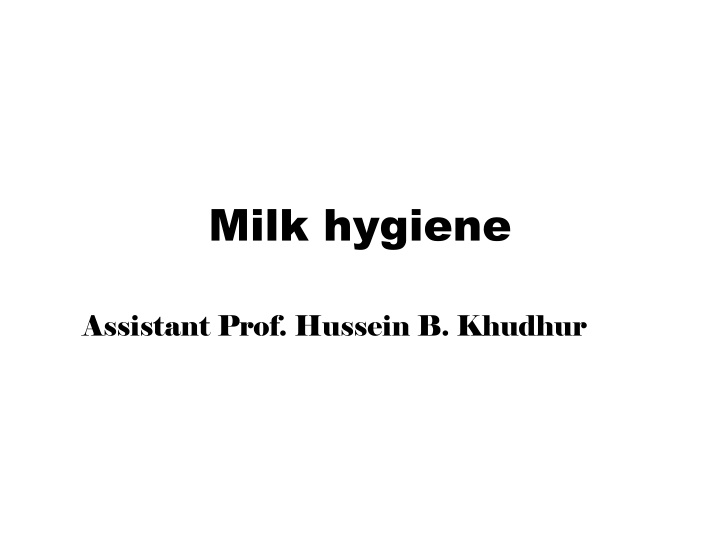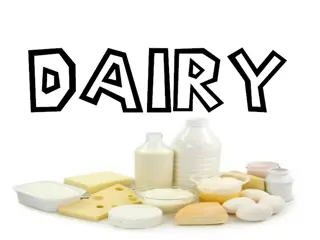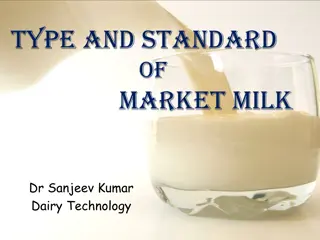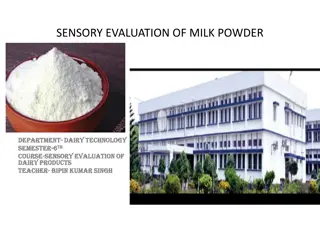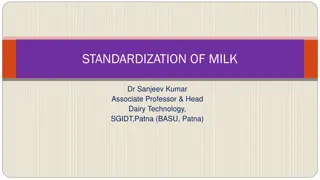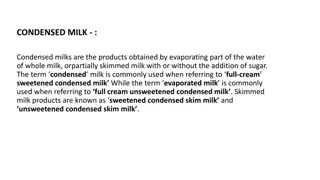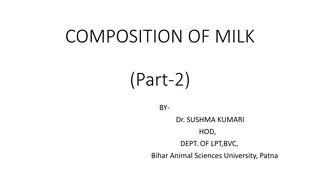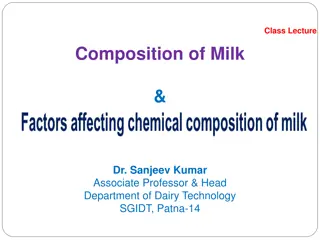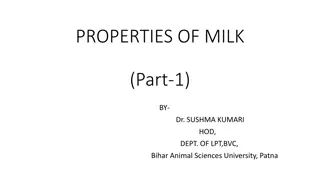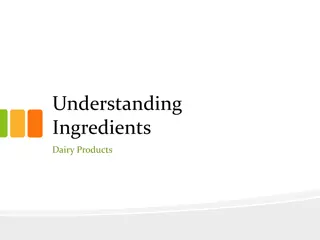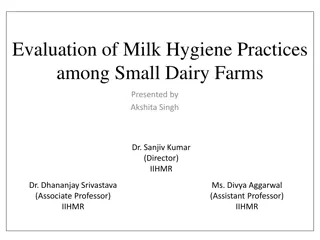Milk Hygiene and Quality
Milk plays a crucial role in public health, but it can also be a carrier of disease-causing organisms if not handled properly. Learn about the factors affecting milk quality, different modes of disease transmission through milk, and the importance of maintaining milk hygiene to prevent milk-borne diseases. Explore how physical and chemical contaminations can impact raw milk quality and steps to ensure safe consumption.
Download Presentation

Please find below an Image/Link to download the presentation.
The content on the website is provided AS IS for your information and personal use only. It may not be sold, licensed, or shared on other websites without obtaining consent from the author.If you encounter any issues during the download, it is possible that the publisher has removed the file from their server.
You are allowed to download the files provided on this website for personal or commercial use, subject to the condition that they are used lawfully. All files are the property of their respective owners.
The content on the website is provided AS IS for your information and personal use only. It may not be sold, licensed, or shared on other websites without obtaining consent from the author.
E N D
Presentation Transcript
Milk hygiene Assistant Prof. Hussein B. Khudhur
Milk may be defined as the whole, fresh, clean, lacteal secretion obtained by complete milking of one or more healthy milch animals, excluding that obtained within 15 days before parturition and 15 days after calving or such periods as may be necessary to render the milk practically colostrum-free, and containing the minimum-prescribed percentages of milk fat and milk solids-not-fat (SNF). Milk and Public Health It is well known that milk can be a potential carrier of disease-producing organisms. Milk-borne epidemics have been reported widely. Proper precautions are necessary to prevent outbreaks of milk-borne diseases, especially if raw milk is consumed. Figure 1 illustrates the factors affecting milk quality at various stages. Diseases can be transmitted through milk, some examples are listed below: 1. Infection of milk directly from the cow: This includes bovine disease, the causative organisms may enter milk through mammary glands and/or through fecal contamination, and may cause a disease condition in persons who consume the milk. Examples include bovine tuberculosis.
2. Infection from man to cow and then to milk: These diseases are essentially human s, but can become established in the cow s udders. Examples include septic sore throat, scarlet fever, and diphtheria. 3. Direct contamination of milk by human beings: These diseases may be transmitted to the milk by direct contamination through human contact. Examples include typhoid fever, dysentery, gastroenteritis, and diphtheria. 4. Indirect contamination of milk by human beings: These include human illnesses; the pathogen causing the human illness may enter milk through contaminating utensils in the milking barn at the farm, water supply, or through insects (carriers) and dust. Examples include typhoid or paratyphoid fever and diarrhea.
Raw Milk Quality: a. Physical contamination: By far the most important physical aspect associated with milk is the temperature from the time of milking to the time of receival at the chilling or processing plant. Small suppliers use ice added to the milk to reduce temperature quickly. The practice of cooling milk by addition of ice dilutes milk, which can make processing difficult. The water from melting ice lowers the concentration of the dissolved and suspended components of milk and alters its processing properties. Poor quality water used to make ice or for rinsing milk utensils in the farm and factory can increase the bacterial counts in the milk. Dust from milking parlors and transport containers can spoil the milk. Poor-fitting lids on milk containers offer little protection from dust contamination during transport. Animal hair is also common in milk obtained by hand milking. Udder hair should be kept clean, and should be clipped short where it is close to teats.
b. Chemical contamination: The main chemicals that can contaminate milk are antibiotics, sanitizers, and detergent or soaps. After treatment of animals to control mastitis, milk is often withheld for too little time. Milk should not be used for consumption for at least 96 hours. Intramammary infusions of penicillin and other antibiotics are now commonly used. The time of withholding milk from treated animals depend on the amount used and frequency of treatment, and the type of antibiotics. Antibiotics are undesirable in milk from the public health view point. Also, the presence of antibiotics in milk precludes its use from cultured products such as yogurts. c. Biological contamination: Large numbers of microorganisms in milk are undesirable for public health and spoilage reasons. Pathogenic organisms can be secreted in the milk from cows suffering from a variety of diseases such as tuberculosis and brucellosis. Spoilage organisms multiply rapidly if the temperature of milk remains above 10 C. While they are not a great public health threat, acid produced by spoilage organisms can render milk unfit for heat treatment or processing.
Raw Milk Quality at the Receiving Bay in a Processing Plant Milk should be inspected immediately on receival. There are four categories of inspection: visual, microbiological. Visual: Milk should be free from extraneous matter such as dust, insects, and should be normal white or white-yellow color dependent on the breed of animal. Sediment and suspended particles can be detected by means of a sediment tester. Organoleptic: This includes smell, appearance, and taste. A check of the container for milk particles after emptying is important. Chemical: Most important chemical test on receival is for developed acidity. Milk with developed acidity will clot on heating and block processing equipment. Microbiological: Plate counts for standard plate counts (SPC) and direct microscopic count are used to assess the microbiological quality of milk. organoleptic, chemical, and
MILK COMPOSITION The composition of milk differs between different mammals, and between different breeds of the same species. Table.2 shows an illustration of the typical composition of milk of different mammals. Water Water is the medium in which all the other components of milk (total solids) are dissolved or suspended. Small amounts of water in milk are hydrated or bound chemically to lactose and salts, and some are bound to proteins. Removal of water from milk such as in concentrated and dried milk products increases its shelf life by reducing water activity. During cheese making, some of the original water content of milk is removed in the form of whey. The water remaining in the curd and cheese furnishes suitable conditions for the chemical and biological reactions upon which cheese making is based, provides moisture
which is essential for the growth and activities of microorganisms and the amount of remaining water in the product influence flavor, body, texture, color, and appearance of the finished product. Regulation prohibits addition of water to raw milk and, also, there is maximum moisture content established for cheese. Milk Lipids: Milk fat is the most variable of all the milk constituents. It is mainly a mixture of triglycerides (TG). The other 1 2% of milk fat is composed of phospholipids, steroids, carotenoids, and fat soluble vitamins A, D, E, and K. Milk fat exists in milk in small globules as an emulsion. These globules are 1 20 in size. Each fat globule is surrounded by an adsorbed layer of other milk constituents, mainly proteins and phospholipids. This stabilizes the fat emulsion and prevents fat from separating out. Because the fat is of lower density than the remainder of the milk, the fat globules tend to rise to the surface, when the milk is allowed to stand undisturbed, giving a cream layer on top of the milk. This property is made use of in the production of cream. Mechanical separators using centrifugal force separate the fat much more efficiently.
Homogenized milk is produced by pumping the milk through a tiny orifice at very high pressures. This breaks down the fat globules to much smaller size which prevents their separation.
Milk Proteins The proteins in milk are partly in solution and partly in colloidal suspension. Milk proteins are of two distinct types, whey protein (serum proteins) and caseins. Casein constitutes over 80% of the total protein in milk, although the relative proportion of whey protein to casein varies according to the stage of lactation. Caseins are subdivided into five main classes: -s1, -s2, , , and kcaseins. Caseins are globular protein with phosphoserine residue which provide them with unique properties. Phosphoserine residues are concentrated in clusters and are responsible for the existence of hydrophobic areas of strong negative charges. The molecules also contain blocks of hydrophobic residues. -Casein contains the most hydrophobic component and forms aggregates with the N-terminal hydrophilic parts exposed to solvent and hydrophobic parts in the interior. -s-Caseins are sensitive to calcium due to the presence of phosphate groups and precipitates in the presence of calcium ions at a pH of 7.0. K-Casein differs from - and -caseins in having only one phosphoserine group and in containing a charged oligosaccharide moiety.
Whey protein comprises -lactoglobulin and -lactalbumins, proteose- peptones (partially derived from hydrolysis of -caseins) and small quantities of the blood-derived proteins, serum albumin, and immunoglobulins. Whey proteins are typical compact globular proteins, with a relatively uniform sequence distribution of nonpolar, polar, and charged residues. These proteins undergo intramolecular folding as a result of the formation of disulphide bonds between cysteinyl residues, which buries most of the hydrophobic residues in the interior of the molecule. For this reason, whey proteins do not aggregate strongly, or interact with other proteins in the native state. The major whey protein, -lactoglobulin, undergoes limited self-association, at milk pH values, to form a dimer with a geometry resembling two impinging spheres. The dimer dissociates in a solution at 60 C, thus becoming susceptible to denaturation by unfolding of the tertiary structure. -Lactalbumin, however, is more heat stable than -lactoglobulin.
